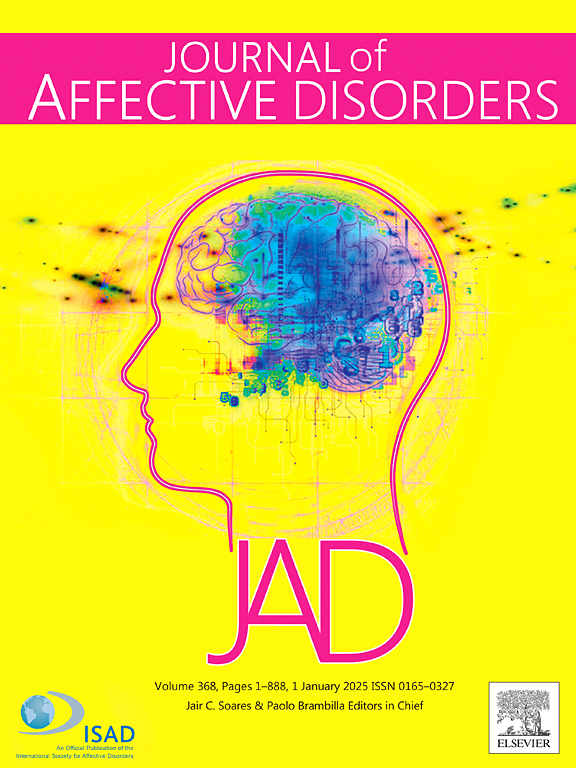Edinburgh postpartum depression scores are associated with vaginal and gut microbiota in pregnancy
IF 4.9
2区 医学
Q1 CLINICAL NEUROLOGY
引用次数: 0
Abstract
Background
Prenatal and postpartum depression may be influenced by the composition of host associated microbiomes. As such, the objective of this study was to elucidate the relationship between the human gut or vaginal microbiomes in pregnancy with prenatal or postpartum depression.
Methods
140 female participants were recruited at their first prenatal visit and completed the Edinburgh Postnatal Depression Scale (EPDS) to screen for depression and anxiety, in addition the EPDS was completed one month postpartum. Vaginal and stool biospecimens were collected in the third trimester, analyzed using 16S rRNA gene sequencing, and assessed for alpha and beta diversity. Individual taxa differences and clustering using the k-medoids algorithm enabled community state type classification.
Results
Participants with higher postpartum EPDS scores had higher species richness and lower abundance of L. crispatus in the vaginal microbiota compared to those with lower EPDS scores. Participants with a higher prenatal EPDS score had lower species richness of the gut microbiome. Participants with a vaginal community state type dominated by L. iners had the highest mean prenatal EPDS scores, whereas postpartum EPDS scores were similar regardless of prenatal vaginal state type.
Limitations
Our small sample size and participant's self-report bias limits generalizability of results.
Conclusions
Depression in the prenatal and postpartum period is associated with the composition and diversity of the gut and vaginal microbiomes in the third trimester of pregnancy. These results provide a foundational understanding of the microbial relationships between maternal health and depression for identifying potential therapeutic treatments.
爱丁堡产后抑郁评分与孕期阴道和肠道微生物群相关。
背景:产前和产后抑郁症可能受到宿主相关微生物组组成的影响。因此,本研究的目的是阐明孕期人类肠道或阴道微生物组与产前或产后抑郁症之间的关系。方法:在首次产前检查时招募 140 名女性参与者,并完成爱丁堡产后抑郁量表(EPDS)以筛查抑郁和焦虑,此外还在产后一个月完成 EPDS。阴道和粪便生物样本在怀孕三个月时采集,使用 16S rRNA 基因测序进行分析,并评估α和β多样性。个体分类群的差异和使用 k-medoids 算法进行的聚类实现了群落状态类型的分类:结果:与 EPDS 分数较低的参与者相比,产后 EPDS 分数较高的参与者阴道微生物群中 L. crispatus 的物种丰富度较高,丰度较低。产前 EPDS 分数较高的参与者肠道微生物群的物种丰富度较低。以L. iners为主的阴道群落状态类型的参与者产前EPDS平均得分最高,而产后EPDS得分与产前阴道状态类型相似:局限性:样本量较小以及参与者的自我报告偏差限制了结果的普遍性:产前和产后抑郁与怀孕三个月肠道和阴道微生物组的组成和多样性有关。这些结果为了解孕产妇健康与抑郁症之间的微生物关系提供了基础,有助于确定潜在的治疗方法。
本文章由计算机程序翻译,如有差异,请以英文原文为准。
求助全文
约1分钟内获得全文
求助全文
来源期刊

Journal of affective disorders
医学-精神病学
CiteScore
10.90
自引率
6.10%
发文量
1319
审稿时长
9.3 weeks
期刊介绍:
The Journal of Affective Disorders publishes papers concerned with affective disorders in the widest sense: depression, mania, mood spectrum, emotions and personality, anxiety and stress. It is interdisciplinary and aims to bring together different approaches for a diverse readership. Top quality papers will be accepted dealing with any aspect of affective disorders, including neuroimaging, cognitive neurosciences, genetics, molecular biology, experimental and clinical neurosciences, pharmacology, neuroimmunoendocrinology, intervention and treatment trials.
 求助内容:
求助内容: 应助结果提醒方式:
应助结果提醒方式:


